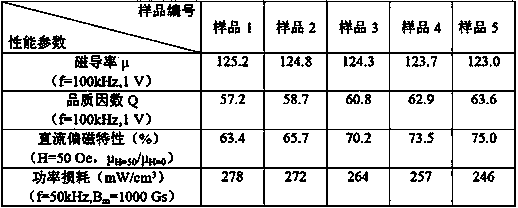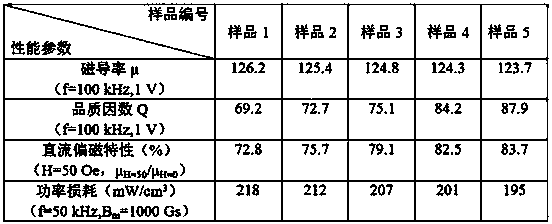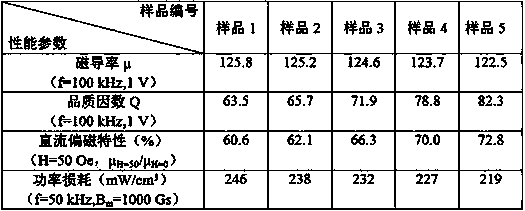Preparing method of metal magnetic powder core
A magnetic powder core and metal technology, which is applied in the direction of magnetic materials, magnetic objects, inorganic materials, etc., can solve the problems of large high-frequency eddy current loss and single shape, improve magnetic performance, improve processing performance, and solve the problem of limited use Effect
- Summary
- Abstract
- Description
- Claims
- Application Information
AI Technical Summary
Problems solved by technology
Method used
Image
Examples
Embodiment 1
[0028] Put the flat powder (containing 4% Si, 15% Al, 5% Ni, and Fe as the balance) prepared by the wet grinding process into a heat treatment furnace, and perform annealing treatment under a nitrogen protective atmosphere at an annealing temperature of 800°C. After 1 h of heat preservation, it was cooled with the furnace. The annealed alloy powder is proportioned according to the following proportions: -100 mesh to +200 mesh particles account for 30% of the total; -200 mesh to +300 mesh particles account for 50% of the total; -300 mesh to +400 mesh Purpose particles accounted for 15% of the total, and the remaining -400 mesh particles accounted for 5% of the total. Add phosphoric acid accounting for 0.5% of the mass of the alloy powder to the prepared powder for passivation treatment, stir evenly and then heat and dry. Then the dried powder is divided into 5 parts on average, numbered 1~5, and the water glass deionized aqueous solution accounting for 0.4%, 0.8%, 1.2%, 1.6% a...
Embodiment 2
[0033] Put the flat powder (containing 6% Si, 13% Al, 3% Ni, 5% Co, and the balance is Fe) prepared by the dry grinding process into a heat treatment furnace, and perform annealing treatment under a nitrogen protective atmosphere. The annealing temperature at 500°C, keep warm for 5 h and then cool down with the furnace. The annealed alloy powder is proportioned according to the following proportions: -100 mesh to +200 mesh particles account for 20% of the total; -200 mesh to +300 mesh particles account for 55% of the total; -300 mesh to +400 mesh Purpose particles accounted for 10% of the total, and the remaining -400 mesh particles accounted for 15% of the total. Add chromic acid accounting for 0.2% of the mass of the alloy powder to the prepared powder for passivation treatment, stir evenly and then heat and dry. Then the dried powder is divided into 5 parts on average, numbered 1~5, and the water glass deionized aqueous solution accounting for 0.4%, 0.8%, 1.2%, 1.6% and 2....
Embodiment 3
[0038] Put the flat powder (containing 9% Si, 12% Al, 2% Ni, 2% Co, 4% Cr, and the balance is Fe) prepared by the wet grinding process into a heat treatment furnace for annealing under a nitrogen protective atmosphere treatment, the annealing temperature was 500 °C, and the furnace was cooled after holding for 5 h. The alloy powder after annealing is proportioned according to the following proportions: -100 mesh to +200 mesh particles account for 25% of the total; -200 mesh to +300 mesh particles account for 40% of the total; -300 mesh to +400 mesh Purpose particles account for 25% of the total, and the rest are -400 mesh particles, accounting for 10% of the total. Add hydrogen peroxide accounting for 1.8% of the alloy powder mass to the prepared powder for passivation treatment, stir evenly and then heat and dry. Divide the dried powder into 5 parts on average, number 1~5, add respectively 0.4%, 0.8%, 1.2%, 1.6% and 2.0% silicone resin acetone solution and 0.5% alloy powder ...
PUM
 Login to View More
Login to View More Abstract
Description
Claims
Application Information
 Login to View More
Login to View More - R&D
- Intellectual Property
- Life Sciences
- Materials
- Tech Scout
- Unparalleled Data Quality
- Higher Quality Content
- 60% Fewer Hallucinations
Browse by: Latest US Patents, China's latest patents, Technical Efficacy Thesaurus, Application Domain, Technology Topic, Popular Technical Reports.
© 2025 PatSnap. All rights reserved.Legal|Privacy policy|Modern Slavery Act Transparency Statement|Sitemap|About US| Contact US: help@patsnap.com



